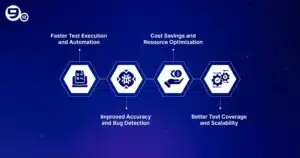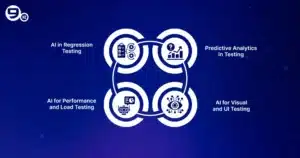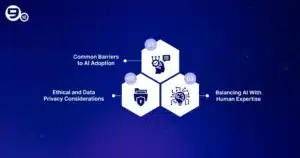It’s shocking that one malformed payload could have leaked customer data through an API edge case. It happens when there are loopholes in testing.
But wait for a second!
A team of quality analysts or software testers spends 30-40% of the total development time testing the software or application, so how can this still happen? Nothing is perfect, and the world is full of uncertainty.
The solution exists for every problem, so here comes AI in software testing that enhances the overall quality analysis process, reducing the manual labor, redundant tasks, and minimizing the overhead cost. AI helps in all the way from test case generation to the prediction of defects.
Similar to the other segments of software development, AI is also reshaping the testing.According to the reports and surveys, Over 73% of organizations are now adopting or experimenting with AI in testing software. The AI-enabled testing market size projections for 2032 is USD 3,824.0 million at a CAGR of 20.9%(2025-2032), and in the existing year 2025 it is USD 1,010.9 million.
These market stats are demonstrating a huge shift in the software testing industry utilizing AI. Artificial Intelligence empowers teams to reduce manual efforts, enhance accuracy, and shorten the testing lifecycle with better results where conventional systems fail.
Let’s explore AI’s role in software testing, benefits, use cases, and more.
Introduction to AI in Software Testing
Before we go deeper into the concept, it would be better to have some basic understanding. Thus, let’s start with the definition part.
What Is AI in Software Testing?
Software testing is to ensure that an application does what it’s supposed to do. It’s the process of checking performance, finding bugs, and confirming that users won’t run into unpleasant surprises. For years, this work has been handled with manual checks or basic automation scripts. The problem? Sometimes, it can be repetitive and miss hidden flaws. That’s not a great scenario especially when you have enterprise grade software.
Get a Free Testing Consultation
Talk to our QA Experts
Request A Free Quote
AI in software testing is all about using smart algorithms, machine learning, and data-driven models to speed up the process and uncover issues that traditional methods often lack. AI-driven software testing, as opposed to conventional methods, may automatically create new test cases, evaluate vast volumes of data, and forecast defects. The result is faster testing, better accuracy, and software that’s more reliable when it reaches the end user.
Why Are Businesses Adopting AI for QA?
AI and Machine Learning are innovative technologies that allow businesses to adapt to futuristic solutions not only in terms of development but also to provide a seamless solution to their end customers, solving their pain points. The best way is to launch software when it’s bug-free and doesn’t have any vulnerabilities. AI makes this happen in a true sense.
This raises a natural question- Why are businesses adopting AI for quality analysis? Here are some top reasons.
-
AI automates repetitive and time-consuming QA tasks and reduces efforts 40-50% ideally. Faster defect detection, minimize development time and helps developers for rapid software delivery.
-
Since Artificial Intelligence automates the testing process, there is a significant reduction in costs, especially when quality analysis is required for large and complex projects.
-
Increased coverage and accuracy make it a perfect choice for enterprises to adopt AI in software testing. AI-driven testing tools can execute complex test cases simply and provide coverage across platforms and devices. Machine learning algorithms learn from historical data and accurately pinpoint defect-prone zones, reducing errors.
-
Analyzing test and operational data, AI predicts potential issues, failures, and vulnerabilities. This capability helps QA teams with proactive risk management, preventing costly defects.
-
Compared with legacy testing frameworks, AI-powered software testing tools update the scripts with the growing testing requirements without a lag. Thus, undoubtedly, this shows the healing test automation capability of AI.
-
The majority of adoption is from enterprises, as AI helps them release updates faster and improve customer satisfaction, gaining them a competitive advantage over competitors.
Why AI Matters in Software Testing
The software development landscape is reshaped, and traditional solutions are a thing of the past. Now, businesses need innovative solutions. Thus, user expectations, rapid release, and a high level of quality assurance are centre stage. Traditional testing systems are not capable of keeping pace with modern software or application development lifecycles. In this scenario, AI brings adaptability, intelligence, and speed to cope with the requirements of the modern software world.
Let’s continue to understand why AI matters!
Challenges of Traditional Testing Methods
Manual Testing Limitations: Manual testing has specific limitations, such as being a time-consuming process, prone to human errors, and incomplete coverage. All these limitations slow down the software development lifecycle and create a gap where a bug might slip and later create havoc.
High Cost: The cost to develop software also includes the cost of testing it, and traditionally, it is a costly affair in terms of resources and tools. The concept is simple: the more complex the software, the more the testing costs.
Frequent Updates: Manual test cases are designed to keep specific versions of the software in mind. Now, the needs evolve rapidly, and frequent updates are required. Manually, it leads to more effort.
Limited Coverage: Conventional methods provide limited coverage for testing the software, and poor scalability creates issues, especially when a system is complex and larger in size.
Less Data Competent: Modern applications such as eCommerce, social media, fintech, and others create a vast amount of data. Manual testing methods fall short in handling this data while testing the software.
How AI Solves These Challenges
-
Automation- AI automates time-consuming tasks and can run thousands of test cases seamlessly, supporting rapid feedback and minimizing manual errors. Machine learning models learn through the situations and generate new test cases, bridging the gaps and with complete coverage, speeding the development cycle.
-
Cost-efficient- By reducing dependencies on resources and automating routine tasks, AI helps lower overhead testing costs. It eliminates the need for repetitive test cycles that often drive up expenses.
-
Adaptable Tests- AI and Machine Learning powered testing tools can adjust with frequent changes and automatically updates test scripts. The flexibility of AI in software testing allows developers and testers for rapid updates and quick release.
-
Broader Coverage- Artificial Intelligence can simulate more user scenarios, identify the hidden issues, and early detect potential vulnerabilities or bugs across platforms and edge cases.
-
Data-Driven Testing- With the ability to process and analyze large datasets, AI can test applications under real-world conditions, such as peak traffic or high-volume transactions.
Expert Insights on AI Adoption in QA
According to the reports, experts’ insights on AI adoption in QA automation are quite impressive. Due to technological evolution and market demands, experts consider AI a transformative force that provides higher efficiency, accuracy, coverage, and intelligence.
CEOs and CTOs from the top companies have stated that AI is the way to bring humans and machines closer together, making the most of the testing process. Here are some experts’ views on using AI in quality analysis.
- Instead of replacement, the QA teams must focus on augmentation and need to understand AI’s role contextually.
- The testing professionals will be required to spot biases, validate data, and ensure that AI models are performing as expected to provide better results. It is about emphasizing data fluency.
- AI can help QA teams blend “Shift-left” and “Shift-right” approaches to produce software faster and with accuracy.
- QA leaders have stated that AI-powered predictive and proactive testing leads to better results, identifying potential bugs and high risks even before they occur.
- The future will be of Agentic AI for quality analysis, where agents can autonomously plan, create, execute, and analyze test cases, and support software or app testing teams to produce something better and unique.
To learn more about AI, check out these helpful blogs
50+ AI App Ideas for 2025 (Profitable & Innovative Startup Concepts)
Artificial Intelligence in IoT: Benefits, Use Cases, and Business Impact
Key Benefits of Using AI in Testing
AI is not just about saving costs, time, and effort; it is about creating impact across the software development lifecycle. The ultimate goal of a development and testing team is to deliver robust software/application aligned with the business goals and offer security to users.
Here are some key benefits from the perspective of a business and QA team.
Faster Test Execution and Automation
Using AI for testing software applications means that a QA team spends less time on repetitive tasks such as data entry, test execution, and report generation and can focus on more important things. The team can think creatively to solve complex challenges and become more efficient and innovative.
Improved Accuracy and Bug Detection
Think about a scenario where a hidden bug caught before the official launch can create a blunder regarding user security. Yes, this can happen due to the predictive capability of AI-powered software testing tools. The team can take the right measures before things go rogue.
Cost Savings and Resource Optimization
AI reduces the need for more resources and manual efforts, which directly saves cost and allows QA teams to better utilize resources. For example, there is no need to hire more resources; a small team can focus on strategy, and AI can handle routine tasks.
Better Test Coverage and Scalability
AI makes sure your testing process can grow with your product. As your software gets bigger and more complex, AI can easily scale up to handle more tests without much extra effort.
Popular AI-Powered Testing Tools
With the increasing demand of innovation in software testing, AI testing tools are essential and must-have in the QA stack. Use of AI testing tools is increasing and its market is anticipated to reach USD 1.63bn by 2030 at a CAGR of 18.4%(2023-2030).
These tools aid testers, developers, and startup founders by improving their workflows. Let’s look at the features of the top AI testing tools.
Top AI Tools for Automated Testing in 2025
- Katalon
- ACCELQ
- Eggplant
- TestGrid
- Parafost
Katalon supports a multitude of platforms, such as web, mobile, desktop, and API. It is easy to use for beginners and experienced testers, and the credit goes to its no-code / low-code recorder and script editor. What makes Katalon fast is applying AI to object handling instead of connecting to design and flow. Testing teams can collaborate, manage, and scale to improve testing.
ACCELQ Autopilot supports enterprise test automation powered by AI. It can create and maintain test cases autonomously when UI elements change or shift. ACCELQ attempts to fix broken tests automatically. Its qualities are version control, traceability, dashboards/reports, and integrations with tools like Jira, so big teams can manage tests seamlessly and streamlined.
If a company is seeking an AI-powered testing tool for user experience and end-to-end testing, Eggplant is the right choice. Using AI, this tool creates a complex model-based flow and executes a test case based on scripts. What sets it apart is using image recognition for testing apps like real users do and manual test automation, enhancing speed and downsizing errors.
TestGrid is also a great choice for AI-powered software testing. The tool optimizes test execution, detects bottlenecks, and suggests fixes. Utilizing smart automation, QA teams can save time, effort, and cost and optimize resources. Some of its key features are AI-driven test case generation, an advanced bug detection mechanism, and cross-platform testing support.
Parasoft SOAtest is known for supporting AI-powered automated software testing. It is the best tool for API and web service testing, especially when teams are involved in testing complex systems and microservice architectures. Parasoft offers built-in features for service virtualization and test data management.
How to Choose the Right AI Testing Tool for Your Team
Several AI-Powered Testing Tools are available for use, but one doesn’t fit all. Therefore, things depend on how you choose the tool for your team. Want to know – How? Here are some steps to choose the right ones.
- Ease of use- When selecting the tool, prioritize your team’s needs first. Check whether the tool supports codeless or low-code testing so non-technical team members can contribute, or if it requires coding knowledge.
- Integration- Ensure that a tool supports CI/CD pipelines, project management tools, and version control systems, and integrate seamlessly with your workflows.
- Cross-platform Support- Almost all AI testing tools support wide coverage, but ensure that the tool you will use supports cross-platform testing.
- Scalability- Always choose a tool that is scalable and expands with your software testing needs. For example, tools should be able to handle complex environments, large data sets, and more tests without a lag.
- Automation- A tool must be able to adjust the script and have automation capability. The auto-update script feature helps when the software or app versions change frequently.
- Analytics & Reporting- Strong dashboards and predictive insights help QA teams focus on essential issues and automate the reporting process to save effort and time.
- Budget- Before you make a decision, check whether the tool’s price suits your budget.
- Support- Ensure the tool provider provides efficient support so that if you have any issues, they will be resolved promptly. Alternatively, if you are going to use open-source AI testing tools, they must have strong community support.
Analyst Reviews and Industry Recommendations
To make the right choice it would be better to get the idea from analysts’ reviews and industry recommendations. The companies can also consult with a reputed software testing company with a proven track record.
Let’s look at what analysts and industry experts recommend.
- Self-healing automation is in demand
- End-to-end or broad coverage is a priority
- Integration with DevOps is essential
- Ease of use drives adoption
- Cost vs. value matters most to enterprises
So based on all of the above mentioned points in this blog section, you can choose the right AI testing tools that suit your needs, budget, and use cases.
Real-World Use Cases of AI in Software Testing
AI in software testing is not a theoretical concept, and experts are using it to drive better and more accurate results. Software testing is an umbrella term, and in reality, there are diverse types of testing techniques. Here, it is how AI helps in combination with these key testing techniques.
Take a look…
How Much Does It Cost to Develop a Supply Chain Software?
AI in Regression Testing
Regression testing is the process of re-running existing tests to ensure that changes or updates have not affected the existing features or functionality. AI in regression testing makes the entire process efficient. AI helps select and prioritize test cases using impact analysis and reduces test suite execution time.
Self-healing automation reduces manual efforts and automatically updates regression test scripts. Additionally, AI-powered visual comparison reduces false positives from cosmetic UI changes, so tests only fail for real issues.
AI for Performance and Load Testing
Performance and load testing check whether the system is capable of handling expected traffic and user interactions and providing a satisfactory user experience. AI helps in performance and load testing by creating synthetic test data mirroring actual usage and modeling real-world traffic and edge behaviors.
Machine learning plays a key role in simulating thousands of concurrent users, analyzing resource utilization, and identifying potential bottlenecks. AI-powered anomaly detection flags abnormal patterns in performance metrics and helps with proactive fixes.
Predictive Analytics in Testing
AI-powered predictive analytics works through data analysis, pattern recognition, and prediction. AI models can be trained on vast amounts of historical data(past test results, defect data), including code complexity and developer activity. Machine learning algorithms are used to identify hidden patterns and trends that can cause future issues. Based on the data analysis and pattern recognition, AI predicts defects that are likely to occur.
AI for Visual and UI Testing
Visual and UI issues are hard to catch, especially because of all the different browsers, screen sizes, and devices. AI-powered visual testing handles this problem well. The AI tool compares how a design is supposed to look with how it looks on a screen and finds any differences. This helps catch things like broken layouts, buttons that are on top of each other, or missing parts that a person might not see. For teams that want to give people a consistent experience, AI helps create the perfect final product.
Case Studies: How Companies Use AI to Improve Testing
The technological evolution driven by Agile methodologies and DevOps has pushed enterprises to deliver high-quality software quickly. In this scenario, traditional methods are ineffective, and AI has appeared as a savior and a game-changer for software testing. To understand how companies use AI to improve testing, it would be better to refer to some real case studies.
How AI Helped a Company Speed Up Software Testing
Google- Smart Test Selection for Faster CI/CD Pipelines
Challenge: Google has a vast digital ecosystem, and there are thousands of code changes and millions of tests to improve user satisfaction. With this tech giant, the challenge was to maintain the relevancy of the tests with the code changes, delivering frequent updates without compromising quality.
Solution: As a solution, engineers designed an AI and Machine Learning powered smart test selection system to optimize the testing process. The system analyzes historical data of test failures, code dependencies, and more. Learning, through data, systems also predict the defects in advance due to code modification.
Result: The smart test selection system has helped Google to have impactful improvement in software development workflows and reduced test execution time by 50% through accelerating CI/CD pipelines.
How AI Enhanced Test Coverage and Quality
Microsoft – AI for Code Coverage Optimization
Challenge: Microsoft manages a multitude of products such as Windows, Azure, Office 365 and others, with millions of lines of code. The organization was facing issues with slow release of updates due to running full test suites and traditional methods were failing in terms of quality and coverage.
Solution: to solve the challenge, Microsoft introduced an AI-based code coverage optimization system. Utilizing machine learning, the system analyzes past bugs, code changes, and developer activities. Based on the risk score, the system suggests areas where extra testing is needed covering all products and code segments. The system keeps updating in real-time with codebase modifications.
Result: Code coverage optimization system helped Microsoft to downsize redundant tests, boosted efficiency up to 30%, provided broad coverage, and improved quality.. QA teams saved resources, regression testing became faster, and products reached the market more reliably and on time.
The above represents some of the top case studies and with the rising role of AI in software testing several case studies exist, indicating the importance and benefits of AI.
Challenges and Limitations of AI in Testing
AI brings advantages to software testing, but some challenges and limitations also exist.
Common Barriers to AI Adoption
Some of the common barriers to AI adoption are:
- High Setup Cost – Some AI testing tools require high investment that a startup or small level business might find difficult to adopt.
- Skill Gap- Skills are required to make the most of AI in software testing and if a QA team lacks skillful resources, it may create challenges for them to use the tools effectively.
- Data-Quality- AI models need a large amount of high-quality, unbiased data to be effective, and many organizations’ data is not ready for this.
- Integration Issues- If existing testing platforms are not compatible with AI, it will create integration issues and workflow will not be seamless.
- Change Resistance- there can be resistance to change from employees who are used to traditional methods and may be worried about AI’s impact on their jobs.
Ethical and Data Privacy Considerations
Data is a fuel for AI systems. If there is bias, then AI can repeat the bias while learning through the data, for example, discrimination against a group of users. In the absence of data governance and encryption, sensitive data may leak during the testing process. Companies need to ensure compliance and transparency before they adopt AI for testing.
Balancing AI With Human Expertise
Although AI can run tests, create scripts, spot patterns, and predict risks, human expertise is still valuable for accuracy and authenticity. Still, the QA team needs to validate the results. Conversely, in combination with AI, human expertise can bring great results. AI helps reduce efforts and costs, and humans can focus on creativity and strategy.
Future of AI in Software Testing
AI is evolving fast and is set to have dominance in the future of software testing. Intelligent automation, deep analytics, and seamless integration of AI into testing tools and platforms will rule in the future.
Upcoming Trends to Watch
- Self-healing Test Automation: Tools will leverage AI to automatically adjust the test scripts to code changes and will minimize human intervention.
- Predictive Testing & Analytics: AI models will be able to analyze bug reports, test results, and code changes to predict the bugs and issues, and areas where they can occur.
- Agentic AI: Integrating agentic AI will reduce the dependency on resources and automate testing cost-efficiently.
- Quantum Computing Synergy: Quantum computing will enhance simulation speed and help test more complex, large-scale systems effectively.
- Generative AI: Generative AI will automatically create new test cases and test data based on a program’s code or design documents.
AI’s Role in DevOps and Agile Pipelines
AI will play a crucial role in DevOps and Agile Pipelines, supporting smarter testing, such as:
- Continuous Testing: AI will help run most relevant test cases based on analyzing data and change in codebase. It will accelerate CI/CD release cycles.
- Shift-Left Testing: QA teams will bring AI-powered testing earlier into the development cycle, preventing issues that may arise later.
- Smarter Regression Testing: Using AI & ML, only relevant test cases will run and there will be no delays in agile sprints.
- Continuous Delivery Support: AI will help software testing teams release updates without compromising the software or app’s quality.
Get a Free Testing Consultation
Talk to our QA Experts
Request A Free Quote
Predictions From Industry Leaders
Experts predict AI will support testers, not replace them, and will require stronger data analysis skills. By 2030, large enterprises will use AI-driven tools in their QA strategy. Some leaders envision autonomous testing agents planning, executing, and analyzing tests with minimal human input.
Conclusion
AI in software testing is a reality, and experts are using it to produce high-quality software aligned with a business’s needs. The future of testing is the collaboration of HUMINT with AI. On the one hand, AI accelerates the testing process, reducing resource dependency, repetitive tasks, and costs, while human expertise focuses on strategy and creativity to create something exceptional. What matters is how you adopt it.
How to Get Started With AI Testing Today?
The best way to start with AI testing is with a pilot project. It will give you an idea of your next step. When using AI, focus on repetitive and time-consuming tasks that create roadblocks for effective testing. The best practice to integrate AI into your software testing process is to integrate it gradually rather than adopting it randomly without knowing its pros and cons.
Finally, measure the results and check whether they are up to the mark. Additionally, to leverage the full advantage of AI & ML, upskill your QA team, building confidence in them that it will enhance their skills not replacing them.
Last but not least, AI will not replace humans, but it will change their roles. Instead of spending time handling repetitive tasks, teams can focus on critical tasks in close collaboration.
FAQs
Can AI be used in software testing?
Yes, of course. AI is applicable for software testing as it is for development and other tasks. Using AI, professionals can generate test cases, automate testing, analyze results, and more. The most significant advantage is reducing cost and effort for repetitive tasks.
Is AI Testing Better Than Manual Testing?
Both methods are best in their own right. AI-powered testing offers speed and scaling and can run thousands of test cases in a minute. On the other hand, human expertise is required for authenticity and creativity.
How Much Does AI-Powered Testing Cost?
The cost of AI-powered testing depends on the type of tool or platform a QA team will use. For example, if you want to use a subscription-based tool, it starts from $49 to $900/ month. However, if you need a custom AI solution for testing, it may cost $50,000 to $150,000.
Can AI Fully Replace Human Testers?
No, AI cannot fully replace human testers. AI still lags in contextual understanding, creative thinking, and emotional intelligence, which are crucial for quality assurance.
Great Together!













